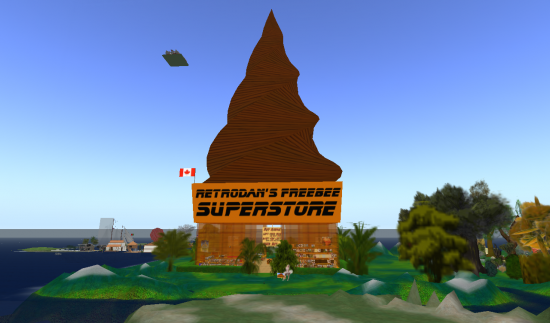Unlike Second Life, the open source virtual world platform OpenSim does not have a built-in currency system. To users, this is a significant lack of functionality – but developers see it as a feature.
The reason? OpenSim is not a clone of the Second Life game – that multi-user virtual environment in which people play as different characters, fight wars, fall in love, and make and sell virtual goods.
Instead, OpenSim is a clone of the Second Life virtual world platform, the underlying server technology on which the game world is built.
A game operator looking to build a Second Life clone on the OpenSim system – and there are many – would have to create their own game content and install a currency system of their own.
The OpenSim server is more like a webserver – a blank slate on which the site operator puts content such as webpages, videos, links, product catalogs, social networking tools and checkouts.
Similarly, operators of OpenSim grids starts with a blank canvas to which they can put buildings and mountains, virtual goods or even three-dimensional store catalogs, meeting facilities, virtual offices, even workplace tools like functioning whiteboards, PowerPoint projectors and display screens. And, of course, shopping carts.
“This is similar to an online merchant deciding whether to use PayPal, credit cards or Google Checkout,†said Charles Krinke, one of the core developers of OpenSim. “In general, it’s good to look at OpenSim and think of it as similar to Apache [web server], where Apache has various modules that can be connected to it. OpenSim, we hope, will become the three-dimensional version of Apache, with a series of associated modules.â€

There are no modules yet for PayPal or Google Checkout, however, since the security issues are still being resolved.
“It’s a factor of stability, security and other things,†said Adam Frisby, head of research and technology at Shanghai-based DeepThink Pty Ltd, and another OpenSim core developer.
There is no technical obstacle, though, to integrating PayPal payments, or PayPal micropayments, into an OpenSim grid deployment.
Until these modules are built, however, there is a quick solution for merchants looking to make money in OpenSim: send customers to a website for the actual payment, Frisby said.
“I expect in the short term, the way to go will be to put credit card details into a webpage that pops up when you click the object [that you want to buy],†he said.
NEW CURRENCIES
Every virtual world has traditionally had its own local currency, whether this was gold pieces in an online role playing game, or Linden Dollars inside Second Life.
Individual grids will probably be the first to offer alternative currencies in the OpenSim framework, Frisby said.
The currencies would be backed by the grid owners – similar to the way that Second Life backs the Linden Dollars.
For example, the Openlife Grid, which is based on the OpenSim platform, has already rolled out its credits system, where US$1 is worth about 450 credits.
Most OpenSim grids however, have not implemented currency systems, including the largest, OSGrid.
For vendors looking for an easier solution than sending customers to an outside website – and who don’t want to wait for grid operators to install grid-wide payment mechanisms – there is one alternative, the V$ currency backed by Dutch developer Arnout Saedt, also known as “ Arnout Sequent†in Second Life and on the OpenSim platforms.
Saedt’s Virtual Wallet system is not backed by a bank, company or even a developer team – just Saedt himself.
The way this system currently works is that the shopper opens an account in Second Life, and deposits money into her Linden Dollar account. Then she transfers some Linden Dollars to Saedt’s personal Second Life account. Saedt tracks the transfer in a database. There are ATMs located at multiple locations in Second Life to make this transfer.
The shopper links her Second Life account with her OpenSim account – or several OpenSim accounts, if she has multiple avatars.
Then the shopper logs out of Second Life and logs into an OpenSim grid, checks her balance on another ATM, and goes shopping.
When she finds a product she likes at a retailer who accepts V$ – most don’t, and simply give away products for free – the cost of the product is deducted from her balance in Saedt’s database.
The merchant, can now link his OpenSim account name with his Second Life account, and go to Second Life to convert his V$ to Linden Dollars, and then, in turn, convert the Linden Dollars to cold hard cash.
There is currently no way to convert V$ directly to US$ or Euros by, say, using PayPal, Saedt told Hypergrid Business.
There are currently 37 ATMs total in three OpenSim grids, he said, including OSGrid, Grid4Us, and Your Alternative Life, as well as in Second Life itself.
Saedt is an unlikely person to be running a payments company. He has never used a credit card, he said, and doesn’t know a point-of-sale terminal from an electronic fund transfer machine.
He also isn’t interested in making money with V$, he said. There are no transaction fees charged to either the shopper or the merchant during V$ payments, he said.
The entire system is funded completely by donations, and Saedt does all the work himself, though other developers occasionally suggest features for the system.
“I don’t expect to get paid for my labor hours,†he said. Other than that, there are no costs to running the system, he said, except for some server time.
“I do not plan to charge for transactions or for the Linden Dollar to Virtual Dollar exchange,†he said. “But I may add PayPal support later and will charge for that.â€
PayPal charges transaction fees, he explained, and those will have to be passed along.
“But I do like the donation-based business model,†he said. “People only pay when they like it. It gives me a better feeling.â€
He is also considering a plan in the future to sell advertisements in the ATMs.

There is an account limit of V$30,000 – or about US$111 – plus a total system cap on daily spending. Saedt declined to say what the cap actually was, citing security concerns, and added that it can fluctuate.
Saedt also declined to say what the total assets under management was, but added that his Linden Dollar reserves were five times the size of the total Virtual Dollar assets.
In case of a dispute, the only resource is Saedt himself, and his database records. There are no external auditors nor any of the standard checks-and-balances found with payment systems. There is no liability insurance. And Saedt doesn’t know the real names of his users – just their Second Life and OpenSim character names.
“I trust the transaction lists and other trails,†he said.
And if shoppers don’t trust those lists?
“Those people should not use it,†he said.
Saedt added that his system has monitoring tools built in to check for suspicious activity, and has some security features in place to guard against people hacking in.
He gave me some details about these features, and declined to provide other details – which is only reasonable, since hackers probably keep a close eye on articles just like this one.
As a result, Saedt said, his system currently has “700 happy friendly users†without a single instance of having to ban someone from the system for malicious activity.
In addition, he said, he personally has to approve each new grid before adding it to his system. After the grid is approved, individual merchants on that grid can then install the payment terminals on their own, without Saedt’s intervention.
“I hope I don’t have to add too many ugly steps,†he said. “Security and user-friendliness don’t go together all the time. It is just a fragile balance. But that depends on the community.â€
So what keeps Saedt from running away with all the money?
“Nothing,†he said. “But I will just not do that.â€
Then he paused, and added: “Reputation, friends, everything.â€
[Update: You can browse all hypergrid-enabled public OpenSim grids with Hyperica, the directory of hypergrid destinations. Directory indexes more than 100 shopping and freebie store locations. Updated hypergrid travel directions here.]
- OSgrid back online after extended maintenance - April 16, 2025
- Analysts predict drop in headset sales this year - March 25, 2025
- OSgrid enters immediate long-term maintenance - March 5, 2025
